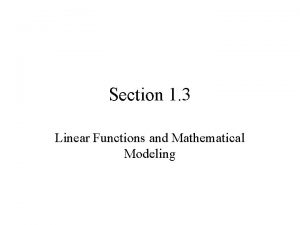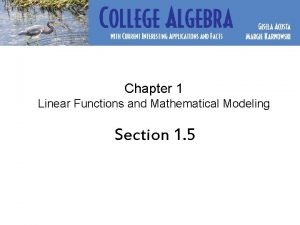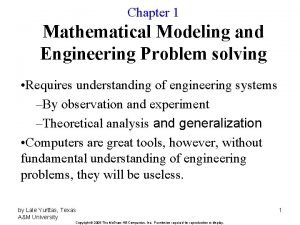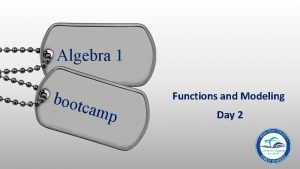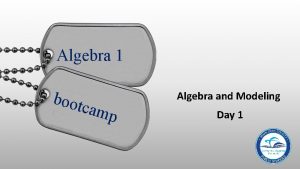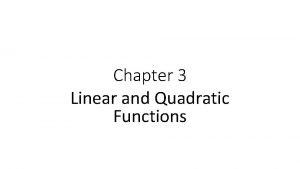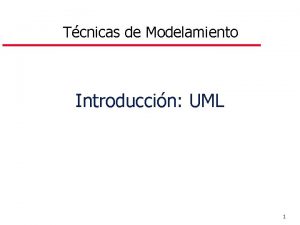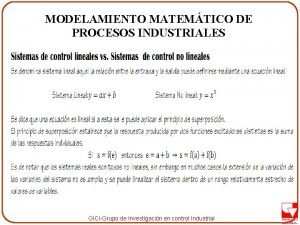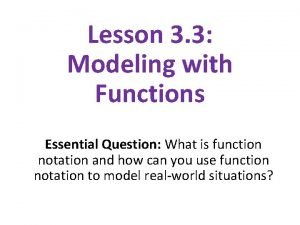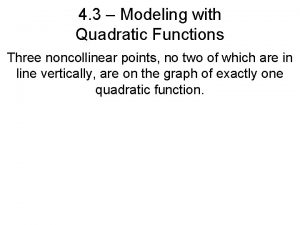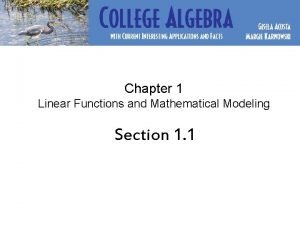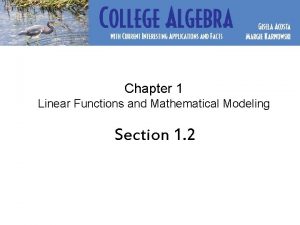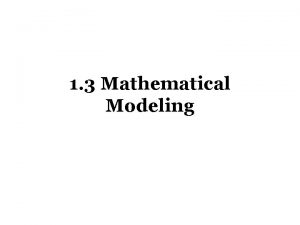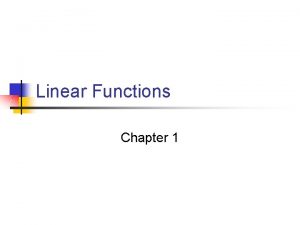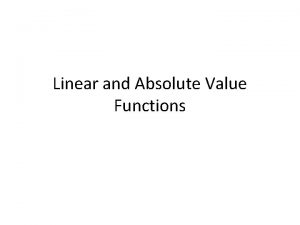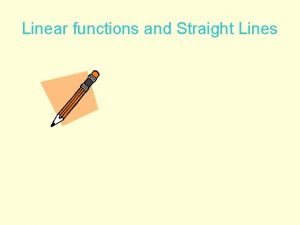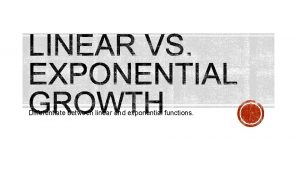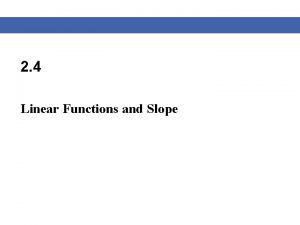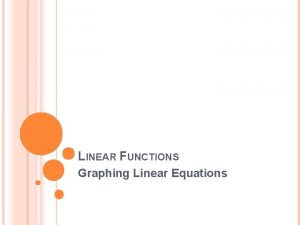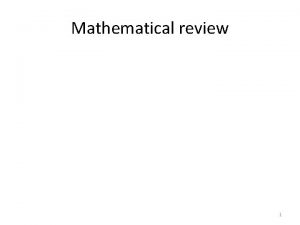Chapter 1 Linear Functions and Mathematical Modeling Section






















- Slides: 22

Chapter 1 Linear Functions and Mathematical Modeling Section 1. 4

Section 1. 4 Interpreting and Evaluating Functions Using Graphs • Graphs of Functions • Identifying Domain and Range from Graphs of Functions • Vertical Line Test • Increasing, Decreasing, and Constant Functions

Graphs of Functions The graph of a function f is the set of all points on the plane of the form (x, f(x)).

Example: Construct the graph of f(x) = 3 x – 4 We can create a table of values, choosing several values for the input and calculating the corresponding outputs. x – 1 0 2 3 f(x) – 7 – 4 2 5 Plotting and connecting the points, the graph of the given function follows:

The graph of a function is shown below. a. Find C(100) means given the input (x-value) of 100, find the output. Therefore, C(100) = 15 b. Find x if C(x) = 10 If C(x) = 10, we are looking for x-values where the output is 10. Therefore, x = 50; 300

The graph of the function f(x) = x 2 + x – 5 is shown below. Use the graph to find the following. a. Find f(– 2). We locate the output, y, when the input, x, is – 2. f(– 2) = – 3, which is equivalent to the point (– 2, – 3) on the graph. b. Estimate and interpret f(0) = – 5. This is the vertical or y-intercept of the function.

(Contd. ) The graph of the function f(x) = x 2 + x – 5 is shown below. Use the graph to find the following. c. Find the input(s) when the output is – 3. We look for any point(s) on the graph where y has a value of – 3. Observe that f(– 2) = – 3 and f(1) = – 3. The inputs are – 2 and 1. d. Find the value(s) of x for which f(x) = 1 is equivalent to y = 1. Thus, f(x) = 1 for x = – 3 and x = 2.

The graph of the function f(x) = –x 2 + x + 6 is shown below. Use the graph to answer the following. a. For what x-values is f(x) 4? Write your answer using interval notation. f(x) 4 means the graph lies on or above y = 4. This occurs when – 1 x 2. In interval notation: [– 1, 2]

(Contd. ) The graph of the function f(x) = –x 2 + x + 6 is shown below. Use the graph to answer the following. b. For what x-values is f(x) < 0? Write your answer using interval notation. f(x) < 0 means the graph lies below y = 0, that is, below the x-axis. This occurs when x < – 2 and x > 3. In interval notation: (– , 2) U (3, )

The graph below illustrates the number of dogs in an animal shelter after a tropical storm has passed through a small town. Let t represent time in days, and n represent number of dogs. a. Identify the input. The input is t, time in days. b. Identify the output. The output is n, number of dogs.

(Contd. ) c. How many dogs are in the shelter in 3 days? 24 dogs d. Find n(0) and interpret its meaning. n(0) = 12. There were 12 dogs in the shelter before the tropical storm. e. Find the value of t for which n(t) = 36. Interpret this value. t = 6. Six days after the storm, there were 36 dogs in the shelter.

Estimate the domain and range for the function whose graph is shown below. Domain (possible values of the input): From the smallest (leftmost) to the largest (rightmost). The domain consists of all x-values less than or equal to 8, thus the domain is given by the interval (– , 8]. Range (possible values of the output): From the lowest (bottommost) to the highest (uppermost). The bottommost y-value is – 6 and the uppermost y-coordinate is 6, therefore, the range is given by the interval [– 6, 6].

Estimate the domain and range for the function whose graph is shown below. Domain: The domain consists of all x-values greater than – 4, thus the domain is given by the interval (– 4, ). Range: The range consists of all y-values greater than or equal to – 6, thus the range is given by the interval [– 6, ).

Vertical Line Test If a vertical line meets a graph more than once, the graph does not represent a function. For each x-value, there can only be one y-value.

True or False: The following graph represents a function. True: It passes the Vertical Line Test. Any vertical line will intersect this graph only once. Notice that for each input there is only one output.

Increasing, Decreasing, and Constant Functions A function is increasing on an interval if it is rising as it goes left to right on the interval. (As x-coordinates increase, y-coordinates increase. ) A function is decreasing on an interval if it is falling as it goes left to right on the interval. (As x-coordinates increase, y-coordinates decrease. ) A function is constant on an interval if the graph is a horizontal line on the interval. (As x-coordinates increase, y-coordinates remain constant. )

Notes We read a graph from left to right, and the interval over which a function is increasing, decreasing, or constant is given only in terms of the x-values. So, we use interval notation referring to the x-coordinates only. Use open intervals (parentheses, not brackets) in the interval notation, since the turning/ending points are neither increasing nor decreasing.

Given the graph of y = f(x), determine the intervals for which the function is (a) increasing, (b) decreasing, or (c) constant. a. The graph rises (increases) from left to right on the interval (– 8, 4). b. The graph falls (decreases) from left to right on the interval (4, 12). c. The function is constant over the interval (– , – 8).

The graph below shows the path of a model rocket launched upward from the ground at an initial velocity of 149 feet per second. Its height, h, at t seconds, can be modeled by h(t) = -16 t 2 + 149 t. a. Use the graph to evaluate h(3) and explain its meaning in the context of the problem. h(3) = 300. After 3 seconds, the model rocket's height going up is 300 feet.

(Contd. ) The graph below shows the path of a model rocket launched upward from the ground at an initial velocity of 149 feet per second. Its height, h, at t seconds, can be modeled by h(t) = -16 t 2 + 149 t. b. Estimate the location of the ordered pair associated with h(4. 7) = 346. 9, and explain its meaning in terms of the problem. (4. 7, 346. 9). After 4. 7 seconds, the model rocket reaches a maximum height of approximately 346. 9 feet.

(Contd. ) c. Estimate the increasing and decreasing intervals. Increasing: (0, 4. 7) Decreasing: (4. 7, 9. 3) d. Estimate the domain and range from the graph. Domain: [0, 9. 3] Range: [0, 346. 9]

Using your textbook, practice the problems assigned by your instructor to review the concepts from Section 1. 4.
 Linear quadratic function
Linear quadratic function Linear functions as mathematical models
Linear functions as mathematical models Linear functions as mathematical models
Linear functions as mathematical models Helen c. erickson
Helen c. erickson Mathematical modeling and engineering problem solving
Mathematical modeling and engineering problem solving Mathematical modeling and engineering problem solving
Mathematical modeling and engineering problem solving Relational vs dimensional data modeling
Relational vs dimensional data modeling Mathematical modeling of electrical systems examples
Mathematical modeling of electrical systems examples Elements of mathematical economics
Elements of mathematical economics Algebra 1 bootcamp functions and modeling answer key
Algebra 1 bootcamp functions and modeling answer key Algebra 1 boot camp
Algebra 1 boot camp Algebra 1 boot camp
Algebra 1 boot camp Algebra 1 bootcamp functions and modeling answer key
Algebra 1 bootcamp functions and modeling answer key Chapter 3 linear and quadratic functions
Chapter 3 linear and quadratic functions I
I Instrumentacion
Instrumentacion Lesson 6-2 transforming quadratic functions
Lesson 6-2 transforming quadratic functions Real world phenomena
Real world phenomena 3-3 modeling with functions
3-3 modeling with functions 4-3 modeling with quadratic functions
4-3 modeling with quadratic functions Polynomial functions of higher degree with modeling
Polynomial functions of higher degree with modeling Math scanner
Math scanner Chapter 3 graphing linear functions answer key
Chapter 3 graphing linear functions answer key

